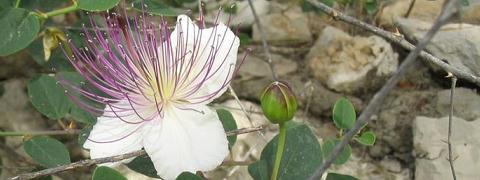[dropcap style=”font-size:100px; color:#992211;”]A[/dropcap]pparently you can eat caper leaves.
They’re described as a spicy salad leaf, and come pickled. They are immersed first in brine, then in wine vinegar after the brine as been drained. Which is much the same process as is applied to capers themselves. For those willing to try them, Greek food shops are your best bet, or you can order them online here.
The reason for opening with a reference to an untried delicacy, and an obscure one at that, is to clear up a misconception about the toothsome little seedpod that is the caper.
[quote]Popular myth claims the
recipe (which translates as
‘spaghetti, whores’ style’) has
it’s origins with the
working girls of Napoli[/quote]
 True capers are nothing to do with the common nastursium, and are in fact the fruit of a hard-stemmed, and hard-as-nails little shrub called Capparis spinosa. The heart-shaped leaves of the true caper plant are dark, glossy and tough, which is why they need such rough treatment before they can be eaten. Nastursium leaves, on the other hand, are a much brighter Kermit green, are soft, and can be eaten directly from the plant.
True capers are nothing to do with the common nastursium, and are in fact the fruit of a hard-stemmed, and hard-as-nails little shrub called Capparis spinosa. The heart-shaped leaves of the true caper plant are dark, glossy and tough, which is why they need such rough treatment before they can be eaten. Nastursium leaves, on the other hand, are a much brighter Kermit green, are soft, and can be eaten directly from the plant.
Which is not to denigrate the nastursium. Few things brighten up a summer salad better than a few nastursium leaves and flowers. The peppery taste of both enlivens the clothiest of lettuces, and if you’ve ever chewed and cudded your way through a seasonal glut of Little Gems, a little novelty of texture and taste is a welcome relief from feeling that you have temporarily morphed into a ruminant beast. Moo.
So, although nastursiums produce a very similar seedpod, and although those seedpods are sometimes confused with capers, they’re not capers. Salted and pickled, nastursium pods are certainly a feisty little ingredient, with a mustardy fire that makes them useful in their own right, but they don’t really fit the same uses. Too overpowering.
Anyway, with that established, onto capers. A gnarly little bush, quite capable of burrowing its hard roots deep into limestone. Which in fact they do, with no regard for the architectural or political significance of their nutrient-gathering activities. The city walls of Palma in Mallorca crumble under them, as does the Wailing Wall in Jerusalem. If there is some allegory there about nature slowly overpowering humanity’s edifices, or the spiritual succour to be gained from a succession of Middle Eastern religious foundations, we’ll leave it to the artists.
A bartop nibble in Menorca, a salad-topper in Sicily. Here, capers are mostly associated with the grey smears dabbed through that tasteless Tartar mayonnaise that comes in a plastic sachet with a Wetherspoon’s fish supper.
Along with almost every highly-flavoured or highly-priced delicacy man has ever put to his lips, capers have been thought to have aphrodisiac properties, and are mentioned in that allegorized context in Ecclesiastes: ‘the almond tree shall flourish, the locust shall be made fat, and the caper tree shall be destroyed’ (Douay-Rheims Bible, Ecclesiastes 12:5). So, bonus! Latterly, modern science attributes a degree of anti-carcinogenic effect to the plant, which contains beneficial glucosinolates. That said, the proportion of said compounds is negligible.
Nevertheless, a fine little berry is the caper, and a crucial ingredient in the intense, and incredibly handy Italian dish Spaghetti a la Puttanesca. Popular myth claims the recipe (which translates as ‘spaghetti, whores’ style’) has it’s origins with the working girls of Napoli, who saw it as a quick and nourishing meal to make after a gruelling day (or night, most likely). More prosaic is the likelihood that the sauce stems from 1960s Syracuse, and the name is some imaginative piece of shock marketing. Either way, its delicious.
[quote]Ingredients
Three cloves of garlic
One canned anchovy fillet
Ten black olives
Ten green olives
A tablespoon of capers (salted or pickled, depending on preference or availability)
A tablespoon of olive oil
A can of decent quality tomatoes, or passata
Optional: a dash of dried chilli flakes/seeds
A glass of red wine
400g Spaghetti[/quote]
Method
Genuine Italian recipes call for more anchovy, usually three. That depends upon your tolerance for the flavour of salted anchovy. One is enough to give the sauce some depth, more than that and the taste of fish is quite strident. Personal preference is key. The same applies to the chilli flakes.
Roughly chop the capers.
Dice the olives as finely as you can manage. This can be a bit of a test of knife-skills, but the smaller the dice, the better the flavour. With most recipes you can chop ingredients as the dish cooks, but with this one, get the olives done in advance of putting the pan on the heat, or you’ll burn the garlic.
Finely chop the garlic cloves, and do the same with the anchovy. Add the oil to the pan, and on a medium to low heat, saute them both. Keep them moving so they don’t stick. When the anchovy has disappeared into the mixture, add the chopped olives and capers.
Turn the heat up to medium-high, keep the mixture moving. When it starts to brown, add the glass of wine, and reduce the liquid down to an almost dry consistency.
Add the tomatoes, with juice, and get your spaghetti water on. Whilst you cook the spaghetti, keep moving the sauce around the pan. You want the sauce to reduce to a slightly grainy consistency, thick enough to cling to your pasta. Leave the chili flakes to the last moment, as burning chili is not fun for anyone.
As soon as the spaghetti is drained, add it to the sauce, or vice versa. Get the pasta well-covered in sauce before it gets sticky.
Plate up. Black pepper and grated parmesan to finish off. Serves two, handsomely.

An observer first and foremost, Sean Keenan takes what he sees and forges words from the pictures. Media, critique, exuberant analysis and occasional remorse.






















Hi, we are small (250 plants) caper growers in South Australia. Just had to correct the reference to caper fruit. Capers are the UNOPENED FLOWER BUDS of the caper plant. Caper Berries are the fruit or seedpod. May have been a problem in translation of course.
Love the Puttanesca recipe. Keeps things simple, Cheers, Barry
Aha! That makes sense. No, it wasn’t a case of translation issues, I didn’t actually know that when I wrote the piece. Makes perfect sense now that you point it out, especially considering what the inside of a caper looks like when you open it up.
So that Italian recipe now has an irony attached. Those poor little capers are still virgins, the poor wee things, and it’s only the berries that get to experience the pleasures of bee-assisted fornication. How unfair to add them to a sauce with such a name!
Thanks Barry, for the education.